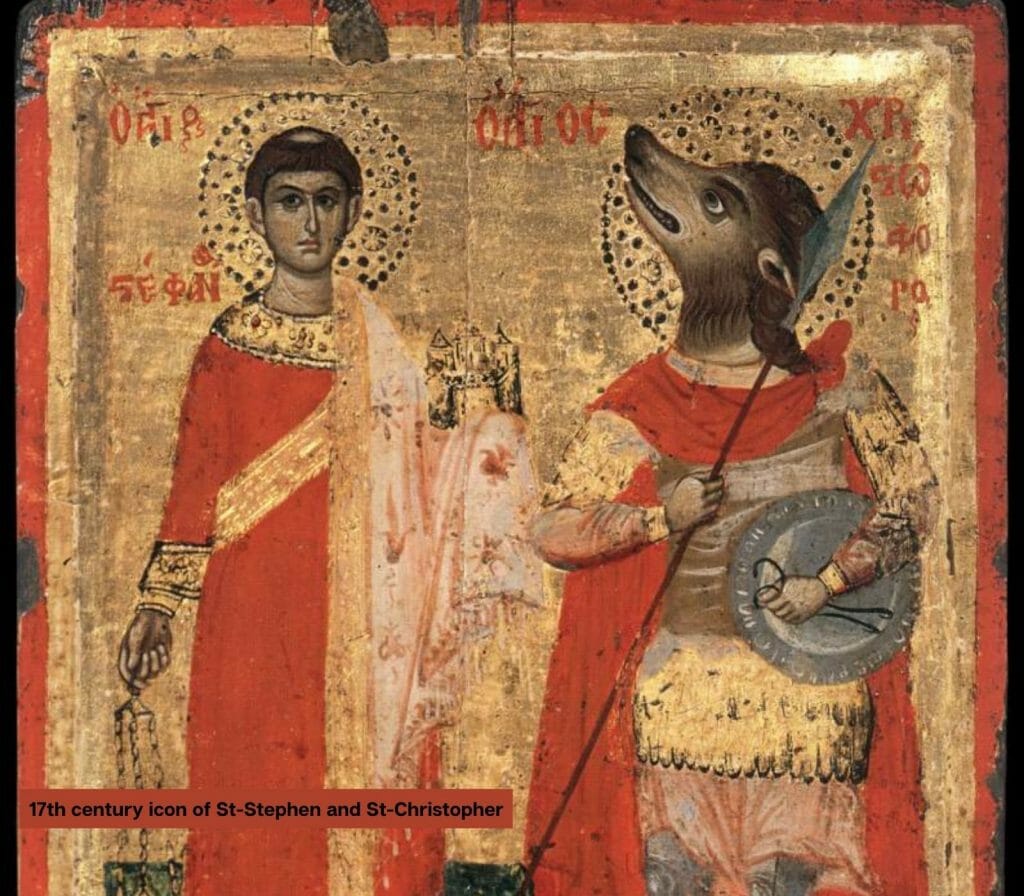Saint Christopher- The Martyr that Barked
A Human saint trailed on a different path than the story of the hound Guinefort. Christopher’s history starts in Canaan (territory that now forms Lebanon, Palestine, Israel, and Syria). According to the local legends, their humans were powerful and ferocious.
A Semantic Confusion
![]() Two Hebrew words were used to define them. One is “Cainite” and the other ‘Canaanites” (sons of Cain). Between the VI and IX centuries, these words formed Caninite, which means the man-dog.
Two Hebrew words were used to define them. One is “Cainite” and the other ‘Canaanites” (sons of Cain). Between the VI and IX centuries, these words formed Caninite, which means the man-dog.
It has also been speculated that this Byzantine depiction of St. Christopher as dog-headed may have resulted from a misreading of the Latin term Cananeus (Canaanite) as caninus, that is, “canine.”
Saint Christopher was born in the northern part of Canaan. When this region was conquered and taken by the Romans during the III and IV Centuries, Saint Christopher was arrested because he was described as a “Caninite Leader”.
He was reported to be of enormous size, with a dog’s head instead of a man (cynocephaly). He and the unit were later transferred to Syrian Antioch, where bishop Peter of Attalia baptized him and where he was martyred in 308.
The literal meaning of “cynocephaly” is “dog-headed”; however that this refers to a human body with a dog head is implied. Such cynocephalics are known in mythology and legend from many parts of the world, including ancient Egypt, India, Greece, and China. In many depictions, Saint Christopher appears as an equal to the Egyptian god Anubis.
That small grammatical and Semantical mistake feeds the popular imagination of the time, which started to think of Saint Christopher as a giant Dog. The official version of his life describes his execution, but the stories told during Medieval times are very far from any grip of reality.
The Will to serve God
In their version, Christopher, a loyal dog, released himself from captivity to find his savior, the King of Kings.
But by that time, Jesus was already dead, and the poor dog could not find him.
The icon of St Christopher is one of the most astounding images found in the Orthodox Tradition. Showing a dog-headed warrior saint, it conjures fantastical stories of werewolves or of monstrous races from Pliny’s edge of the world.
He met a hermit who instructed him in the Christian faith.
Christopher asked him how he could serve Christ. When the hermit suggested fasting and prayer, Christopher replied that he was unable to perform that service.
The hermit then suggested that Christopher could serve Christ because of his size and strength by acts of charity such as assisting people to cross a dangerous river where they were perishing in the attempt. The hermit promised that this service would be pleasing to Christ.
One day, when trying to help a child cross, St Christopher noted that the boy was getting progressively heavier. He felt that as they were facing the treacherous currents of the river.
He had to use all his inner strength to finish the crossing. When he arrived at the other side of the river, he noticed that the child was one of the manifestations of Christ.

Saint Christopher’s Dog’s head; The Church Explanation
To finish up the many stories about the Dog-man saint, The Catholic church explained that the selfless acts from Christopher purified his soul.
In doing such acts, he ended up cleansing himself of what they called the curse of Canaan.
This way, he supposedly got a human face, a pure spirit, elements enough to get himself canonized on the XV Century.
In the Eastern Orthodox Church, specific icons covertly identify Saint Christopher with the head of a dog. Such images may carry echoes of the Egyptian dog-headed god, Anubis. Christopher pictured with a dog’s head is not generally supported by the Orthodox Church, as the icon was proscribed in the 18th century by Moscow.
Read more about Saint Christopher inside the Orthodox Church here





